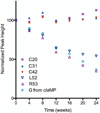Stability analysis of an inline peptide-based conjugate for metal delivery: nickel(II)-claMP Tag epidermal growth factor as a model system
- PMID: 25212829
- PMCID: PMC4312271
- DOI: 10.1002/jps.24132
Stability analysis of an inline peptide-based conjugate for metal delivery: nickel(II)-claMP Tag epidermal growth factor as a model system
Abstract
Metals are a key component of many diagnostic imaging and biotechnology applications, and the majority of cancer patients receive a platinum-based drug as part of their treatment. Significant effort has been devoted to developing tight binding synthetic chelators to enable effective targeted delivery of metal-based conjugates, with most successes involving lanthanides rather than transition metals for diagnostic imaging. Chemical conjugation modifies the protein's properties and generates a heterogeneous mixture of products. Chelator attachment is typically carried out by converting the amino group on lysines to an amide, which can impact the stability and solubility of the targeting protein and these properties vary among the set of individual conjugate species. Site-specific attachment is sought to reduce complexity and control stability. Here, the metal abstraction peptide technology was applied to create the claMP Tag, an inline platform for generating site-specific conjugates involving transition metals. The claMP Tag was genetically encoded into epidermal growth factor (EGF) and loaded with nickel(II) as a model system to demonstrate that the tag within the homogeneous inline conjugate presents sufficient solution stability to enable biotechnology applications. The structure and disulfide network of the protein and chemical stability of the claMP Tag and EGF components were characterized.
Keywords: MAP; NMR; absorption spectroscopy; analytical biochemistry; chromatography; conjugation; metal abstraction peptide; protein structure; stability; targeted drug delivery.
© 2014 Wiley Periodicals, Inc. and the American Pharmacists Association.
Conflict of interest statement
JSL is co-owner of Echogen Inc., a limited liability company that has licensed the patent-protected metal abstraction peptide (MAP) technology from the University of Kansas.
Figures






Similar articles
-
Metal-bound claMP Tag inhibits proteolytic cleavage.Protein Eng Des Sel. 2017 Jun 1;30(6):467-475. doi: 10.1093/protein/gzx030. Protein Eng Des Sel. 2017. PMID: 28541524 Free PMC article.
-
claMP Tag: a versatile inline metal-binding platform based on the metal abstraction peptide.Bioconjug Chem. 2014 Jun 18;25(6):1103-11. doi: 10.1021/bc500115h. Epub 2014 May 21. Bioconjug Chem. 2014. PMID: 24807049 Free PMC article.
-
EGF receptor-targeting peptide conjugate incorporating a near-IR fluorescent dye and a novel 1,4,7-triazacyclononane-based (64)Cu(II) chelator assembled via click chemistry.Bioconjug Chem. 2014 May 21;25(5):1011-22. doi: 10.1021/bc5001388. Epub 2014 Apr 30. Bioconjug Chem. 2014. PMID: 24758412
-
Dinuclear Nickel(I) and Palladium(I) Complexes for Highly Active Transformations of Organic Compounds.Molecules. 2018 Jan 11;23(1):140. doi: 10.3390/molecules23010140. Molecules. 2018. PMID: 29324677 Free PMC article. Review.
-
Organometallic-Peptide Bioconjugates: Synthetic Strategies and Medicinal Applications.Chem Rev. 2016 Oct 12;116(19):11797-11839. doi: 10.1021/acs.chemrev.6b00166. Epub 2016 Sep 14. Chem Rev. 2016. PMID: 27627217 Review.
Cited by
-
Thioredoxin fusion construct enables high-yield production of soluble, active matrix metalloproteinase-8 (MMP-8) in Escherichia coli.Protein Expr Purif. 2016 Jun;122:64-71. doi: 10.1016/j.pep.2016.02.012. Epub 2016 Feb 23. Protein Expr Purif. 2016. PMID: 26923061 Free PMC article.
-
Metal-bound claMP Tag inhibits proteolytic cleavage.Protein Eng Des Sel. 2017 Jun 1;30(6):467-475. doi: 10.1093/protein/gzx030. Protein Eng Des Sel. 2017. PMID: 28541524 Free PMC article.
References
-
- De León-Rodríguez LM, Kovacs Z. The Synthesis and Chelation Chemistry of DOTA-Peptide Conjugates. Bioconjugate Chem. 2008;19(2):391–402. - PubMed
-
- Breeman WAP, Kwekkeboom DJ, de Blois E, de Jong M, Visser TJ, Krenning EP. Radiolabelled regulatory peptides for imaging and therapy. Anti-Cancer Agents Med Chem. 2007;7(3):345–357. - PubMed
-
- Wängler C, Buchmann I, Eisenhut M, Haberkorn U, Mier W. Radiolabeled peptides and proteins in cancer therapy. Protein Pept Lett. 2007;14(3):273–279. - PubMed
-
- Knör S, Modlinger A, Poethko T, Schottelius M, Wester H-J, Kessler H. Synthesis of novel 1,4,7,10-tetraazacyclodecane-1,4,7,10-tetraacetic acid (DOTA) derivatives for chemoselective attachment to unprotected polyfunctionalized compounds. Chem - Eur J. 2007;13(21):6082–6090. S6082/6081-S6082/6020. - PubMed
-
- Lewis MR, Kao JY, Anderson A-LJ, Shively JE, Raubitschek A. An improved method for conjugating monoclonal antibodies with N-Hydroxysulfosuccinimidyl DOTA. Bioconjugate Chem. 2001;12(2):320–324. - PubMed
Publication types
MeSH terms
Substances
Grants and funding
LinkOut - more resources
Full Text Sources
Other Literature Sources

